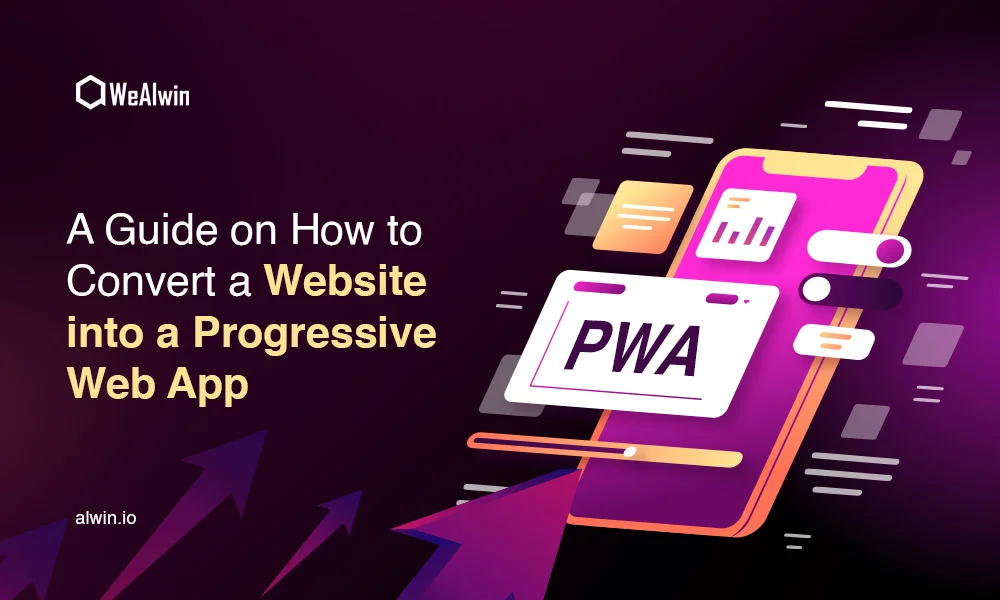Have you ever dreamed of making your website just as interactive and user-friendly as a mobile app? It's time to turn that dream into reality by converting your website into a Progressive Web App (PWA)! PWAs combine the best of web and mobile apps, offering offline capabilities, fast loading times, and an engaging user experience. By the end of this guide, you'll understand the steps needed to transform your website into a PWA, ensuring your users enjoy a top-notch experience regardless of their device or network conditions. Let's dive in!
PWA Conversion
Transforming your website into a progressive web app (PWA) can significantly enhance its performance, making it more engaging and user-friendly. Before diving into the conversion process, let's understand the nitty-gritty of PWAs.
Benefits of Converting Your Website into a PWA
Switching to a PWA can offer numerous advantages:
Improved Performance: PWAs load faster than traditional websites, providing a smoother experience for your users.
Offline Access: Users can access your website offline or on low-quality networks, thanks to service workers.
Engagement Boost: Features like push notifications can help you maintain user engagement and increase return visits.
Enhanced User Experience: PWAs are designed to work on any device, providing a consistent and responsive experience across all platforms.
How PWAs Work?
At its core, a PWA uses modern web capabilities to deliver an app-like experience. Key components include:
Service Workers: Scripts that run in the background and help with offline support and content caching.
Web App Manifest: A JSON file that defines the appearance and behavior of your PWA, such as its name, icons, and display properties.
HTTPS: Ensuring data transmitted is secure and tamper-proof
The Conversion Process: How to Get Started
Converting your website into a PWA might sound daunting, but breaking it down into manageable steps can simplify the process.
Assessing Your Website
Begin by evaluating your current website's structure, performance, and functionality. Identify essential elements and those that can be improved or removed. This assessment will give you a clearer picture of the work ahead.
Set Clear Goals for the Conversion
Decide on what you aim to achieve with your PWA. Do you want to improve load times, increase engagement, or ensure your site is accessible offline? Setting clear, measurable goals will guide your conversion process and help you evaluate its success.
Tools and Resources Needed
To transform your website into a PWA, you’ll need some tools and resources:
Lighthouse: An open-source, automated tool for improving the quality of web pages, including PWA functionalities.
PWA Builder: A tool that packages your website into a PWA, generating the necessary service worker and manifest files.
Web Developers: Depending on your technical expertise, you might need to collaborate with developers experienced in PWA development.
By understanding the basics of PWAs, assessing your website, setting clear goals, and gathering the right tools, you’re well on your way to converting your website into a powerful progressive web app.
Step-by-Step Guide to Converting Your Website into a PWA
Step 1: Implement HTTPS
Before you dive into the progressive web app (PWA) realm, ensuring your website is served over HTTPS is a must. This not only secures your website by encrypting data but is also a fundamental requirement for PWA features, like service workers, to function. You can start by obtaining an SSL/TLS certificate, which has become more accessible and often free through services like Let’s Encrypt.
Step 2: Add a Web App Manifest
The web app manifest is a JSON file that controls how your app appears to the user and how it can be launched. This includes specifying the home screen icons, the page to load when the app is launched, screen orientation, and even the app’s name. A well-configured manifest ensures your website feels more like a native app on the user’s device.
Step 3: Service Workers and Caching
Service workers are at the heart of making your website a PWA, acting as a proxy between the web app and the network. They allow your app to load faster and work offline by caching key resources. Implementing service workers involves writing JavaScript that tells the browser what to cache and how to retrieve the cached content when offline or on a poor connection.
Step 4: Responsive Design and Load Speed Optimization
Responsiveness and speed are key components of a good user experience. A PWA must look good and perform well on any device, from desktops to smartphones. Techniques like image optimization, minifying CSS and JavaScript, and using responsive design principles are essential. Fast loading times can be achieved through efficient code, caching strategies, and choosing the right hosting environment.
Step 5: Testing and Debugging
Testing is an ongoing part of developing a PWA. Use tools like Lighthouse to evaluate your app’s performance, accessibility, progressive enhancements, and adherence to PWA criteria. Testing on various devices and debugging issues as they arise ensures your PWA offers a consistent and reliable experience.
PWA Development Best Practices
Offline Functionality
Ensure your PWA can work offline or with a poor connection by using service workers for caching. This not only improves the user experience but also encourages users to return, knowing they can rely on your app even in challenging conditions.
Push Notifications
Push notifications can help engage and retain users by reminding them to return to your PWA for updates, offers, or new content. Just remember, user consent is critical, so always seek permission before sending notifications.
App-Like Experience
Design your PWA to mimic the feel and performance of a native app. This includes implementing smooth transitions, gesture controls, and an app-like user interface. The goal is to blur the lines between web and native apps for your users.
Security Considerations
Beyond implementing HTTPS, consider other security protocols to protect user data and ensure secure transactions. Regular security audits, following best practices for web development, and staying updated with the latest security patches are crucial for maintaining a safe environment for your users.
Promoting and Launching Your PWA
After you’ve put in the work to convert your website into a Progressive Web App (PWA), it’s time to make sure people know about it and use it. Promoting and launching your PWA effectively is crucial for its success.
SEO for PWAs
Search Engine Optimization (SEO) for PWAs isn’t vastly different from SEO for any website, but there are a few specific considerations. First, ensure your PWA is indexable by search engines. This means making your content accessible and crawlable. Use server-side rendering or prerendering if necessary. Next, ensure your site is fast and has a high-performance score on tools like Google's Lighthouse. Also, make sure to have a web app manifest and service worker registered, as this signals to search engines that your site is a PWA and can lead to better rankings.
Submitting to App Stores
While one of the charms of PWAs is bypassing app store submissions, you can still opt to submit your PWA to various app stores like the Google Play Store or Microsoft Store for added visibility. This process involves meeting the specific criteria of each store, such as having a manifest file, meeting performance standards, and packaging your PWA correctly. Submissions to app stores can help reach a broader audience who might not stumble upon your site via a web search.
User Training and Support
Offering training and support to your users can significantly improve their experience with your PWA. Create tutorials, guides, or even video walkthroughs showing how to get the most out of your PWA. Ensure you have a responsive support team ready to answer any questions or troubleshoot any issues users might encounter. Great support not only improves user satisfaction but can also turn users into advocates for your app.
Reasons to Convert Your Existing Website to PWA
Converting your existing website into a Progressive Web App can bring numerous benefits, improving both the user experience and your site’s performance.
Reliability: PWAs work offline or on low-quality networks, making your site more reliable and accessible to everyone, everywhere.
User Engagement: With the ability to send push notifications and use a full-screen experience without the browser address bar, PWAs drive higher user engagement.
Cost-Effective: Building a PWA is often more cost-effective than developing a native app for multiple platforms while still providing a similar user experience.
SEO Benefits: As PWAs are essentially websites, they're indexable by search engines, which can improve your site's visibility and traffic.
Converting to a PWA is not just about keeping up with trends; it's about offering a superior, more accessible, and more engaging experience to your users.
Transforming your website into a Progressive Web App (PWA) might sound daunting initially, but by following the steps we've outlined, you're on your way to enhancing your visitors' experience. Remember, the transition to a PWA not only improves user engagement through fast loading times and offline accessibility but also positions your site favorably in search engine rankings. So, take the leap, work through the process, and watch your site evolve into a more accessible, reliable, and engaging platform for your audience.
Searching for a top PWA development company to transform your normal website into a progressive web app then WeAlwin is your top priority.



